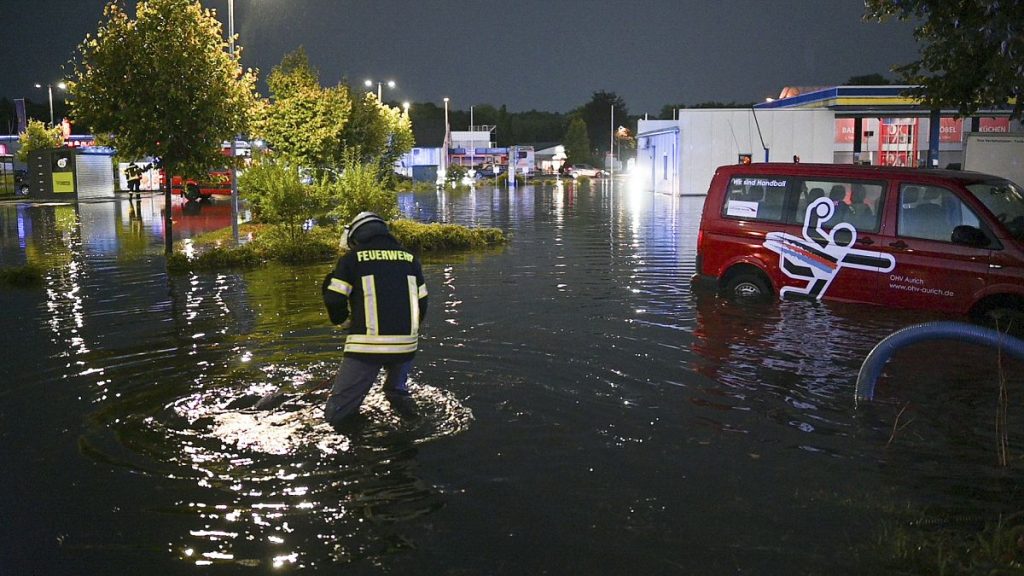Extreme weather, including severe thunderstorms and heavy rainfall, has devastated Germany and Belgium following soaring temperatures in both countries. In Germany, regions such as North Rhine-Westphalia, Lower Saxony, Bavaria, and Baden-Württemberg were most affected by the storms, which were triggered by intense heat. The storms are expected to move towards Schleswig-Holstein and Mecklenburg-Western Pomerania in the coming days. Severe weather warnings were issued in North Rhine-Westphalia, where rain and hail flooded streets, motorways, and cellars. Thankfully, emergency services were able to respond quickly, resulting in no serious injuries reported. Additionally, flooding occurred in areas such as Baden-Württemberg, Bavaria, and East Frisia, where a hospital had to be secured against flooding.
In Belgium, the Royal Meteorological Institute (KMI) issued an amber warning for the Limburg and Liège Provinces, while the rest of the country was under a code yellow. The capital Brussels and the Antwerp province have had to close off streets due to flooding, with the district of Wilrijk in Antwerp receiving 39mm of rain in just one hour. The KMI noted that August’s rainfall record had already been broken, with 100mm of rainfall recorded at the weather station in Brussels compared to the average of 86.5mm for the month. The extreme weather conditions have caused significant disruptions and damage in both countries, highlighting the urgent need for preparedness and response measures to mitigate the impact of such events in the future.
The severe thunderstorms and heavy rainfall in Germany and Belgium have brought about significant challenges for residents and authorities alike. While emergency services have been deployed to affected areas to assist with relief efforts, the widespread damage caused by the storms has led to concerns about the safety and well-being of the affected populations. The storms have resulted in flooded streets, motorways, and cellars, as well as disruptions to transportation networks such as railway tracks. The impact of the extreme weather has underscored the importance of effective disaster response and preparedness strategies to ensure the timely and efficient deployment of resources to mitigate the effects of such events.
In Germany, the Rhineland-Palatinate region experienced temperatures of 36.5C prior to the onset of the severe thunderstorms, highlighting the intensity of the weather conditions that have unfolded in recent days. The storms, which were triggered by the extreme heat, have affected various regions across the country, including North Rhine-Westphalia, Lower Saxony, Bavaria, and Baden-Württemberg. The rapid succession of extreme weather events, from soaring temperatures to severe thunderstorms, has placed additional strain on emergency response teams and resources, necessitating a coordinated and efficient approach to addressing the needs of affected communities. The storms’ movement towards other regions in the coming days underscores the ongoing challenges posed by the unpredictable nature of weather events and the importance of adaptive strategies to respond effectively.
The impact of the severe weather in Belgium has also been significant, with the Royal Meteorological Institute (KMI) issuing warnings for several provinces as a result of the extreme rainfall and flooding. The closure of streets and disruptions to daily life in areas such as Brussels and the Antwerp province have underscored the vulnerability of urban areas to the effects of extreme weather events. The record-breaking rainfall in August further highlights the need for improved forecasting and early warning systems to enable timely and effective response measures. The challenges posed by the extreme weather conditions in Belgium serve as a reminder of the importance of resilience-building efforts and the adoption of sustainable practices to mitigate the impact of climate change on vulnerable communities.
Overall, the severe thunderstorms and heavy rainfall in Germany and Belgium, following soaring temperatures, have highlighted the urgent need for enhanced preparedness and response measures to address the impacts of extreme weather events. The widespread damage and disruptions caused by the storms emphasize the importance of adaptive strategies and coordinated efforts to ensure the safety and well-being of affected populations. The record-breaking rainfall and flooding in both countries serve as a stark reminder of the growing threats posed by climate change and the need for proactive measures to build resilience and reduce vulnerabilities. As the storms continue to impact various regions, it is crucial for authorities, emergency services, and communities to work together to effectively respond to the challenges posed by extreme weather events and ensure the protection of lives and livelihoods.


